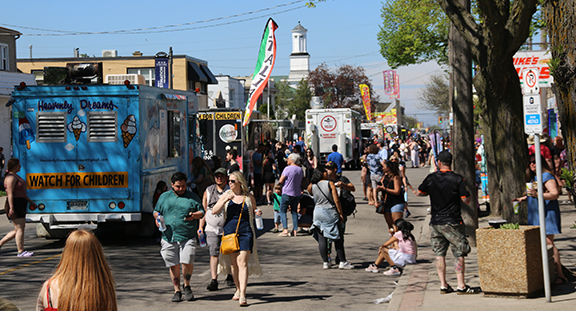Famished for the food truck

Ottawa Street’s Sew Hungry began in 2013 as a way to celebrate Hamilton’s burgeoning food truck culture. Both are still going strong.
As Ottawa Street gears up for the return of Sew Hungry on May 11, the food truck scene in Hamilton has never been more vibrant. Hamilton was an early adopter of the food truck trend and it remains strong to this day, with dozens of different operators serving up a multitude of cuisines.
Origins
Every part of the world has had some variation of a food cart in its history. No matter where you go, they are almost always run by enterprising individuals with a knack for making delicious food who bring their offerings to the roadsides for ordinary working people to enjoy a well-cooked meal.
Within the North American context, the origin of the modern food truck is often traced to post-Civil War Texas, where former Confederate soldier and rancher Charles Goodknight invented the “chuck wagon,” a horse-drawn covered wagon outfitted with wood burning stoves, kitchenware and a water barrel. Chuckwagons were intended to feed cowboys on the long cattle drives across the state to New Mexico and back again.
Covered wagons would subsequently find usage back east, such as Walter Scott’s lunch wagon in Providence, Rhode Island, which served up sandwiches, hot coffee and pies to journalists and staff at the newspaper office where it was parked day and night.
The 1950s saw the evolution of the wagons into “mobile canteens,” as well as the more familiar invention of the ice cream truck since vehicles could now have refrigerators and freezers on board.
Food trucks catered to working people – farmers, factory workers, retail staff, and busy office personnel – providing affordable, convenient and delicious food. Rich folks tended to look down on them as “roach coaches” or “gut trucks,” preferring traditional fine dining in brick and mortar restaurants.
That perception would change in the late 2000s and early 2010s, especially following the start of the Great Recession in 2008. A confluence of three factors led to the rapid evolution of the food truck as we know it today: a surplus of available food trucks at relatively low cost; a large number of unemployed cooks and chefs due to restaurant closures; and the rapid growth of social media. In low-income neighbourhoods and suburbs across the continent, food trucks started rolling up to various locations to serve long lineups of hungry diners, alerted to their arrival on Twitter and Instagram (a practice most notably pioneered by L.A.’s Kogi, operated by Chef Roy Choi).
Better yet, food truck offerings had diversified, with a wider range of cuisines from all around the world, as well as unique innovations provided by the individual chefs. As the trend caught on, food truck rallies started to appear in many cities, with dozens of new food trucks lining up on the street and drawing in thousands of people.
City governments, at varying speeds, adjusted their local food safety and permit processes to allow for food trucks to operate legally within their bounds. It was within this context that the first-ever Sew Hungry rally was held in 2013 on Ottawa Street.

The legacy of Graeme Smith
The Hamilton food truck community of today owes a great debt of gratitude to chef Graeme Smith, the founder of Gorilla Cheese, Canada’s first food truck devoted to grilled cheese sandwiches, and an original favourite at Sew Hungry.
Having had a lifelong dream to own a restaurant, Smith attended Hamilton’s Liaison College and developed what would become the Gorilla Cheese menu. As the food truck scene started to take hold elsewhere in North America, Smith decided to open his own.
Smith held the launch for Gorilla Cheese at Hamilton City Hall in 2011, and with the partnership of fellow chef Jonathan Tjerkstra, a.k.a, Jonny Blonde, was able to pave the way for today’s thriving Hamilton food truck scene. “There was no food truck industry when Graeme started,” said Blonde in a CBC news article on Smith’s leadership. “He really did a lot of the legwork for a lot of us in getting through to the City and making it possible to do what we do because there just was no legislation and stuff like that for us.
Smith would grow Gorilla Cheese into one of the most successful Hamilton businesses, briefly owning a brick and mortar restaurant on Ottawa Street from 2015 to 2018.
In 2017, Smith was diagnosed with oropharyngeal cancer, which he would battle for the next five years before passing away in January 2022. An entire local food truck industry owes its existence to Smith’s passion, vision, and love of people. Gorilla Cheese continues to operate, serving customers throughout southern Ontario.
Food truck futures
Much has changed in the past 13 years for Hamilton’s food truck industry. The added pressures of operating in the post-2020 environment and all of the economic pressures that has brought for the hospitality industry in general are certainly felt by many operators.
“These days, the audience can be pretty fickle,” says chef Mandip Kaler of the Flying Gnosh, comparing today’s food truck scene to the early 2010s. “Now that the ‘new car smell’ has worn off, the customer is not as excited to visit many events as before.” He notes that being able to cook and run a food business without the investment of a physical location is still a great advantage. “A truck lets you bring your food and concept to a wide array of customers and locations.”
Kaler has been able to collaborate with many brick and mortar businesses in Hamilton, most recently helping to launch a beer, the Flyin’ Lassi Sour with Mango, with Grain & Grit Small Batch Brewing in the city’s west end.
Sew Hungry continues to be touted as “Canada’s largest food truck festival”, and as of this writing, the Ottawa Street BIA, the primary festival organizers, are still adding new trucks to the lineup, but if the 2023 festival (with more than 33 trucks) is any indication, Sew Hungry 2024 should be one of the best events to look forward to this year.












